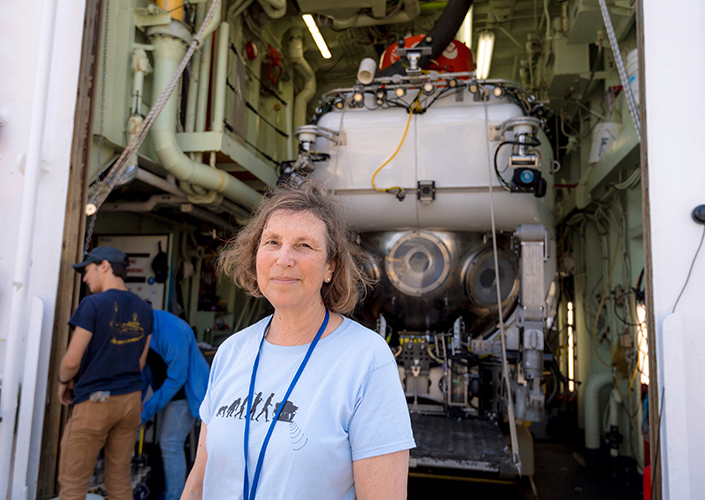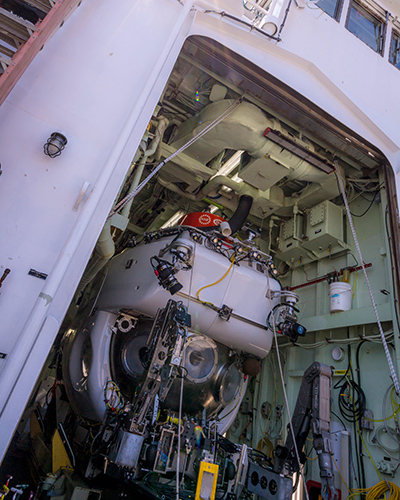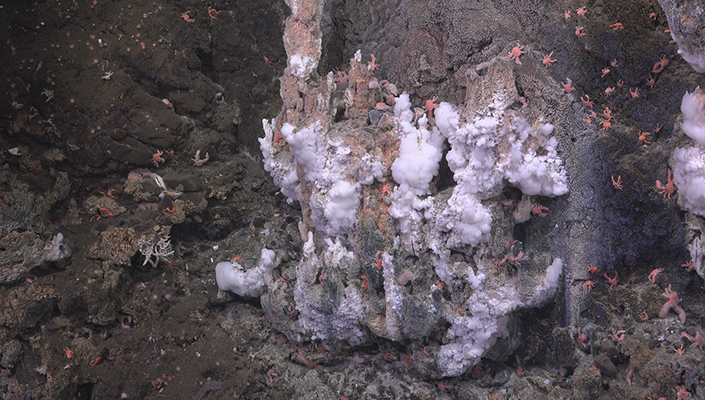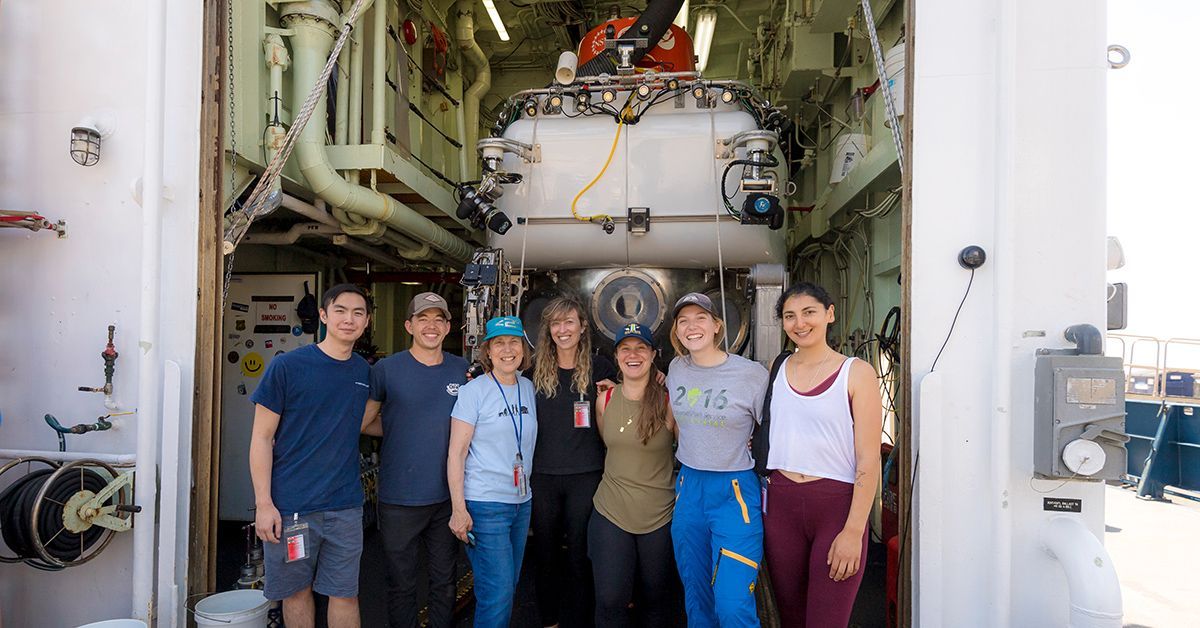Scripps Researchers to Explore Deep-Sea Methane Seeps in Alvin Submersible
Expedition hopes to better understand how far the chemicals from seeps spread underwater, and which organisms can utilize them as a food source.
Story by:
Published Date
Article Content
UC San Diego Scripps Institution of Oceanography professor emerita Lisa Levin is set to explore the poorly understood deep-sea ecosystems surrounding methane seeps off the coast of Southern California using the Alvin human-occupied submersible.
The 14-day National Science Foundation (NSF)-funded voyage aboard the Woods Hole Oceanographic Institution’s (WHOI) R/V Atlantis departed July 16 to study where the methane emerging from these seeps goes and how far its biological sphere of influence extends.
Levin is the expedition’s chief scientist but shares principal investigator duties with a trio of other leading female deep-sea researchers: Victoria Orphan of CalTech, Shana Goffredi of Occidental College, and Tina Treude of UCLA.
Levin has completed more than 50 dives aboard the three-person Alvin and said that at this point the sub “feels like home.” Operated by WHOI and owned by the U.S. Navy, Alvin has been in operation since 1964 and has made immeasurable contributions to the study of the deep ocean over the course of more than 5,100 dives, including safely delivering the first human explorers to the sunken remains of the Titanic.
The NSF-funded Alvin will allow Levin and her colleagues to study up close the sunless ecosystems that surround the parts of the seafloor that leak methane.
“Alvin always gets the job done and is extremely safe,” said Levin. “It’s a different way of experiencing the deep sea. You’re there in the deep sea and you can see what’s going on in more detail than if you were watching a video feed at the surface.”

Unlike deep-sea hydrothermal vents, methane seeps are not hot, but these two unusual habitats share a common feature found in few ecosystems on Earth: They are fueled by chemical energy rather than sunlight. At methane seeps, some organisms have evolved the ability to consume methane, a powerful greenhouse gas that occurs naturally in the seafloor and is often created by microbes breaking down organic material.

In some places, methane escapes from rocks or sediment on the seafloor in the form of bubbles. Levin explained that these seeps are quite common and mostly occur along continental margins, the edges of our coastal waters, between 300 and 1,200 meters (984 to 3,937 feet) deep. The microbes that can survive by processing methane create the base of a food web cut off from the sun that includes clams, worms, sponges, crabs, octopus, and fish such as dover sole, sablefish, and rockfish.
“Most of the methane released by these deep-water seeps doesn’t reach the surface because it is consumed by microbes and animals,” said Levin. “We need that because it helps keep methane out of the atmosphere where it would fuel climate change. If we damage these animals and microbes we could be destroying a really important natural process that helps regulate the climate.”
Levin and the rest of the scientists on the expedition hope to figure out how far the methane emerging from these seeps spreads underwater and which animals can make use of it.
“We think that methane can be used by a broader range of organisms than is currently understood to do this,” said Levin. “The methane from these seeps may have a larger biological footprint than we realized.”
If Levin and her colleagues can show that more microbes and animals are utilizing methane farther from the seeps, it could have important implications for conservation since some of these seeps are being considered for protection from exploitation. Studying microbes that consume methane could also provide novel insights relevant to fighting climate change.
“These seeps host an amazing array of microbial processes that we are still discovering and are relatively untapped when it comes to industrial applications and climate change applications such as methane or carbon capture,” said Levin. “We should be looking to these ecosystems to help us solve some of our problems on land.”
The team will journey as deep as 1,020 meters (3,346 feet) beneath the surface in Alvin at seeps located off coastal cities such as Del Mar (discovered by Scripps students in 2012), Santa Monica, Palos Verdes, Redondo Knoll, and La Jolla Reef in Los Angeles and San Diego counties. Each dive will collect animal specimens, water samples, sediment and rock samples, and observations for analysis back on board the ship. None of these dives will come close to Alvin’s maximum operating depth of 6,500 meters (21,325 feet).
“We are trying to redefine the biological footprint of a methane seep,” said Levin. “The visual we get of patches of animals like clams or tube worms may cover half a square kilometer, but if we can show the methane itself is spreading out farther and fueling more animals than we realized, then we can expand the recognized footprint of a methane seep and that could have significant conservation implications.”

The Lasuen Knoll methane seep off the coast of Southern California as photographed in 2021. Credit: Schmidt Ocean Institute
Following this expedition in Southern California’s waters, Levin and many of the same researchers will set off to the Aleutian margin near Alaska in mid-May 2024 to survey its methane seeps, some of which are up to 5,500 meters deep (18,044 feet).
Other Scripps researchers on the expedition include: Charlotte Seid (Benthic Invertebrate Curator), Olivia Pereira (PhD student in the Levin Lab), Michelle Guraieb (MS student), Francis Nguyen (MS student), and Ailish Ullmann and Devin Vlach, both Scripps alumni.
Share This:
You May Also Like
Stay in the Know
Keep up with all the latest from UC San Diego. Subscribe to the newsletter today.




